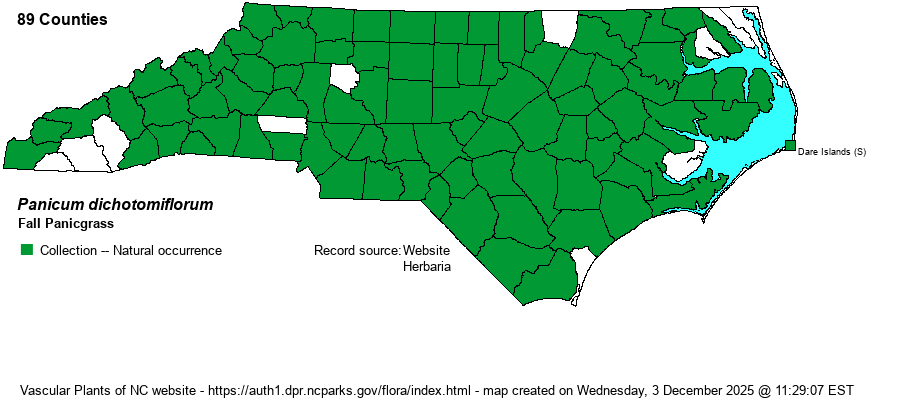| Author | Michaux | |
| Distribution | Throughout the state, but scarce on the Outer Banks.
N.S. to southern MN and NE, south to FL and TX; adventive westward. | |
| Abundance | Essentially common throughout, though perhaps less so in the far northeastern counties and in some southern Mountain ones. Rare on the Outer Banks. | |
| Habitat | Moist to wet shores of ponds and impoundments, beaver ponds, roadside ditches, river shores and sandbars, alluvial deposits; sometimes also in drier soils of fallow fields and other disturbed sites. |
| Phenology | Flowering and fruiting July-October. | |
| Identification | The lower portions of the stems of Fall Panicgrass normally recline and root at the nodes. The middle and upper portions are much-branched, ascending, and produce inflorescences 6 inches to a foot long, with several spikelets along the branchlets. The plants are glabrous (without noticeable hairs). The nominate variety differs from var. puritanorum by the overall greater size and larger spikelets (2.2-3.8 mm long vs. 1.8-2.2 mm long in that variety). | |
| Taxonomic Comments | There are two varieties in the state -- the widespread nominate one and the quite rare var. puritanorum, limited to just two south coastal counties so far.
The genus Panicum in the broad sense was once very large, but with the split of Dichanthelium in the 1980s, it has been reduced to manageable size. In more recent decades, other genera have been split off: Coleataenia, Hymenachne, Kellochloa, and Phanopyrum, as examples. All 6 of these genera can be readily told from each other in the field with just a hand lens. For a more detailed discussion, see the introductory paragraphs in Weakley (2018). | |
| Other Common Name(s) | Fall Panicum | |
| State Rank | S5 | |
| Global Rank | G5 | |
| State Status | | |
| US Status | | |
| USACE-agcp | FACW link |
| USACE-emp | FACW link |

